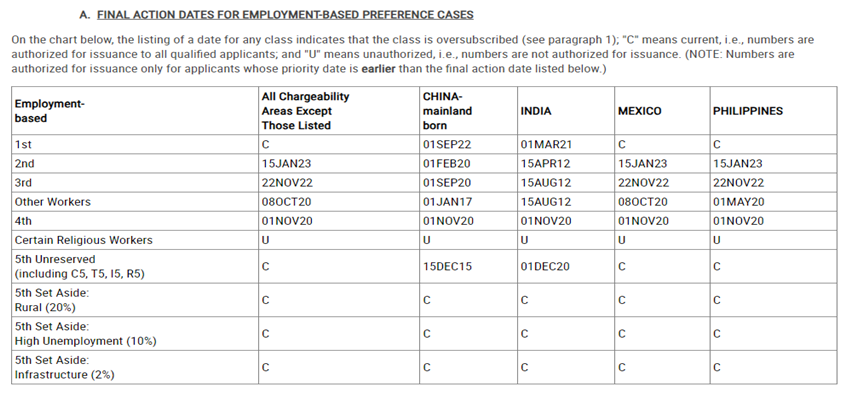Immigration
Immigration News June 2024
FINAL ACTION DATES FOR EMPLOYMENT-BASED PREFERENCE CASES
The Department of State issues the visa bulletin every month which publishes information regarding when employment-based applicants will have available green cards. The bulletin shows when the applicant’s status becomes “current.”
There are substantial green card backlogs for citizens from countries such as China, India, Mexico, and the Philippines. Therefore, it is important for citizens of India to check the visa bulletin every month.
The visa bulletin summarized the availability of immigrant numbers during June for: “Final Action Dates” and “Dates for Filing Applications,” indicating when immigrant visa applicants should be notified to assemble and submit required documentation to the National Visa Center.

Visa Bulletin Summary and Explanation of Categories
Employment-Based, First Preference (EB1) Category
First: Priority Workers: 28.6% of the worldwide employment-based preference level, plus any numbers not required for fourth and fifth preferences.
(If you are a noncitizen of extraordinary ability, are an outstanding professor researcher, or are a certain multinational executive or manager.)
The cutoff date for EB1 India moved to February 1, 2022. While dates for Mexico and the Philippines are current, China’s cutoff date is November 1, 2022
Employment-Based, Second Preference (EB2) Category
Second: Members of the Professions Holding Advanced Degrees or Persons of Exceptional Ability: 28.6% of the worldwide employment-based preference level, plus any numbers not required by first preference.
In the EB2 category, the cutoff date now is June 15, 2012. For China, the cutoff date moves ahead to March 1, 2020.
Employment-Based, Third Preference (EB3) Category
Third: Skilled Workers, Professionals, and Other Workers: 28.6% of the worldwide level, plus any numbers not required by first and second preferences, not more than 10,000 of which to "*Other Workers.”
For EB3 India, the cutoff date moved up to September 22, 2012.
Employment-Based, Fourth Preference (EB4) Category
Fourth: Certain Special Immigrants: 7.1% of the worldwide level. (EB4 is generally issued to religious workers or international organization workers)
In the EB4 category, the cutoff date for all countries moves up to January 1, 2021.
Employment-Based, Fifth Preference (EB5) Category
Fifth: Employment Creation: 7.1% of the worldwide level, of which 32% are reserved as follows: 20% reserved for qualified immigrants who invest in a rural area; 10% reserved for qualified immigrants who invest in a high unemployment area; and 2% reserved for qualified immigrants who invest in infrastructure projects. The remaining 68% are unreserved and are allotted for all other qualified immigrants.
In the EB5 category, India’s unreserved (i.e., EB5 immigrant visa numbers not set aside for rural, high unemployment, and infrastructure projects) cutoff date advances to December 1, 2020.
USCIS INCREASES AUTOMATIC EXTENSION OF CERTAIN EMPLOYMENT AUTHORIZATION DOCUMENTS TO IMPROVE ACCESS TO WORK PERMITS
- The agency announced a temporary rule to increase the automatic extension period for Employment Authorization Documents (EADs) from 180 to 540 days.
- The extension is meant to help noncitizens who are already authorized to work avoid gaps in employment while waiting for USCIS to process their pending EAD renewal applications.
- It may also help stabilize U.S. employers by preventing disruptions to their operations caused by delays in work authorization renewals.
- The extension is available to certain applicants who filed Form I-765 (Application for Employment Authorization) renewal applications on or after October 27, 2023.
USCIS UPDATES GUIDANCE FOR FAMILY-BASED IMMIGRANT VISAS
- In recent news, USCIS is updating its policies for family-based immigrant visa petitions, including Form I-130 and some Form I-260 petitions.
- If you are filing Form I-130 for a relative, you must provide USCIS with the beneficiary’s current address and state whether they prefer consular processing or adjustment of status.
- Previously, USCIS would keep approved petitions if it was unclear whether the beneficiary wanted adjustment of status or consular processing. The new guidance clarifies procedures to make processing more efficient when the beneficiary’s preference is unclear, has changed, or when a correction is needed.
- If you do not specify whether your beneficiary wants consular processing or adjustment of status, USCIS will decide based on the beneficiary’s most recent address.
- The new guidance also explains how to contact USCIS to correct errors or update the beneficiary’s location and preference.
The Contributor of these articles is, Madhurima Boyapati Paturi. She is currently Immigration/Legal Chair for ATA. Disclaimer: The information provided herein is for public service and may not apply to any specific or particular circumstance. This information is not intended as, and should not be taken as, legal advice .Please consult an attorney about your particular factual and legal circumstances.

 Join our
Join our






































